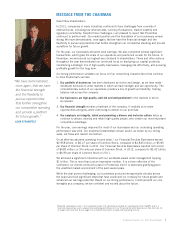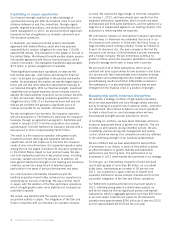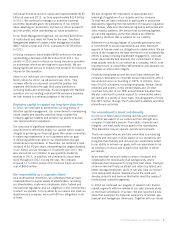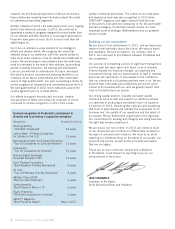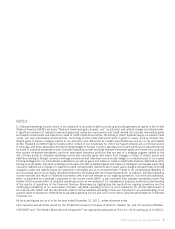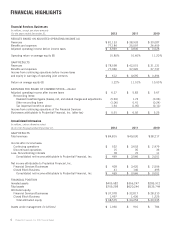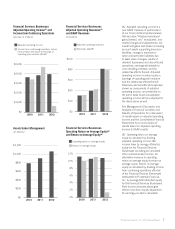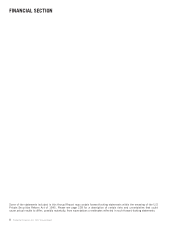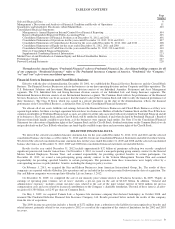Prudential 2012 Annual Report Download - page 13
Download and view the complete annual report
Please find page 13 of the 2012 Prudential annual report below. You can navigate through the pages in the report by either clicking on the pages listed below, or by using the keyword search tool below to find specific information within the annual report.
(1) For purposes of this computation, earnings are defined as income from continuing operations before income taxes excluding undistributed income (loss)
from equity method investments, fixed charges and interest capitalized. Also excludes earnings attributable to noncontrolling interests. Fixed charges
are the sum of gross interest expense, interest credited to policyholders’ account balances and an estimated interest component of rent expense. Due to
the Company’s loss for the year ended December 31, 2008, the ratio coverage was less than 1:1 and is therefore not presented. Additional earnings of
$1,133 million would have been required for the year ended December 31, 2008 to achieve a ratio of 1:1.
The historical information presented in the table above has been revised to reflect the impact of retrospective adoption of the amended
guidance related to the deferral of acquisition costs as well as the impact of retrospective application of a change in method of an
accounting principle for the Company’s pension plans. For further information, see “—Accounting Policies and Pronouncements—
Adoption of New Accounting Pronouncements” and Note 2 to the Consolidated Financial Statements.
MANAGEMENT’S DISCUSSION AND ANALYSIS OF FINANCIAL CONDITION AND
RESULTS OF OPERATIONS
You should read the following analysis of our consolidated financial condition and results of operations in conjunction
with the “Forward-Looking Statements,” “Selected Financial Data” and the “Consolidated Financial Statements” included in
this Annual Report, as well as the “Risk Factors” included in Prudential Financial’s 2012 Annual Report on Form 10-K.
Overview
Prudential Financial has two classes of common stock outstanding. The Common Stock, which is publicly traded (NYSE:PRU),
reflects the performance of the Financial Services Businesses, while the Class B Stock, which was issued through a private placement and
does not trade on any exchange, reflects the performance of the Closed Block Business. The Financial Services Businesses and the Closed
Block Business are discussed below.
Financial Services Businesses
Our Financial Services Businesses consist of three operating divisions, which together encompass six segments, and our Corporate
and Other operations. The U.S. Retirement Solutions and Investment Management division consists of our Individual Annuities,
Retirement and Asset Management segments. The U.S. Individual Life and Group Insurance division consists of our Individual Life and
Group Insurance segments. The International Insurance division consists of our International Insurance segment. Our Corporate and Other
operations include corporate items and initiatives that are not allocated to business segments, as well as businesses that have been or will be
divested.
We attribute financing costs to each segment based on the amount of financing used by each segment, excluding financing costs
associated with corporate debt which are reflected in Corporate and Other operations. The net investment income of each segment includes
earnings on the amount of capital that management believes is necessary to support the risks of that segment.
We seek growth internally and through acquisitions, joint ventures or other forms of business combinations or investments. Our
principal acquisition focus is in our current business lines, both domestic and international.
Closed Block Business
In connection with the demutualization, we ceased offering domestic participating products. The liabilities for our traditional domestic
in force participating products were segregated, together with assets, in a regulatory mechanism referred to as the “Closed Block.” The
Closed Block is designed generally to provide for the reasonable expectations for future policy dividends after demutualization of holders
of participating individual life insurance policies and annuities included in the Closed Block by allocating assets that will be used
exclusively for payment of benefits, including policyholder dividends, expenses and taxes with respect to these products. See Note 12 to
the Consolidated Financial Statements and “Business—Demutualization and Separation of Business” included in Prudential Financial’s
2012 Annual Report on Form 10-K for more information on the Closed Block.
Revenues and Expenses
We earn our revenues principally from insurance premiums; mortality, expense, asset management and administrative fees from
insurance and investment products; and investment of general account and other funds. We earn premiums primarily from the sale of
individual life insurance, group life and disability insurance, and certain annuity contracts. We earn mortality, expense, and asset
management fees primarily from the sale and servicing of separate account products including variable life insurance and variable
annuities, and from the sale and servicing of other products including universal life insurance. We also earn asset management and
administrative fees from the distribution, servicing and management of mutual funds, retirement products and other asset management
products and services. Our operating expenses principally consist of insurance benefits provided and reserves established for anticipated
future insurance benefits, general business expenses, dividends to policyholders, commissions and other costs of selling and servicing the
various products we sell and interest credited on general account liabilities.
Profitability
Our profitability depends principally on our ability to price our insurance and annuity products at a level that enables us to earn a
margin over the costs associated with providing benefits and administering those products. Profitability also depends on, among other
items, our actuarial and policyholder behavior experience on insurance and annuity products, our ability to attract and retain customer
assets, generate and maintain favorable investment results, effectively deploy capital and utilize our tax capacity, and manage expenses.
Historically, the participating products included in the Closed Block have yielded lower returns on capital invested than many of our
other businesses. As we have ceased offering domestic participating products, we expect that the proportion of the traditional participating
products in our in force business will gradually diminish as these older policies age, and we grow other businesses. However, the relatively
Prudential Financial, Inc. 2012 Annual Report 11


